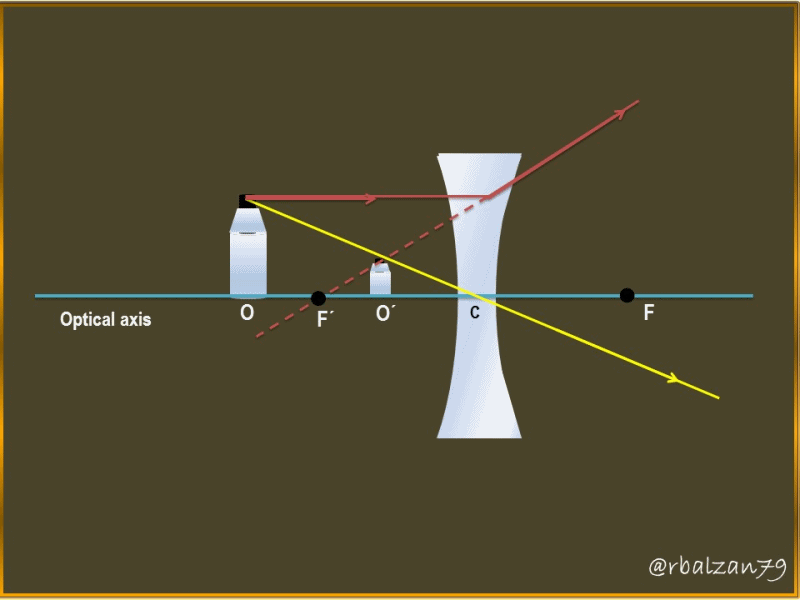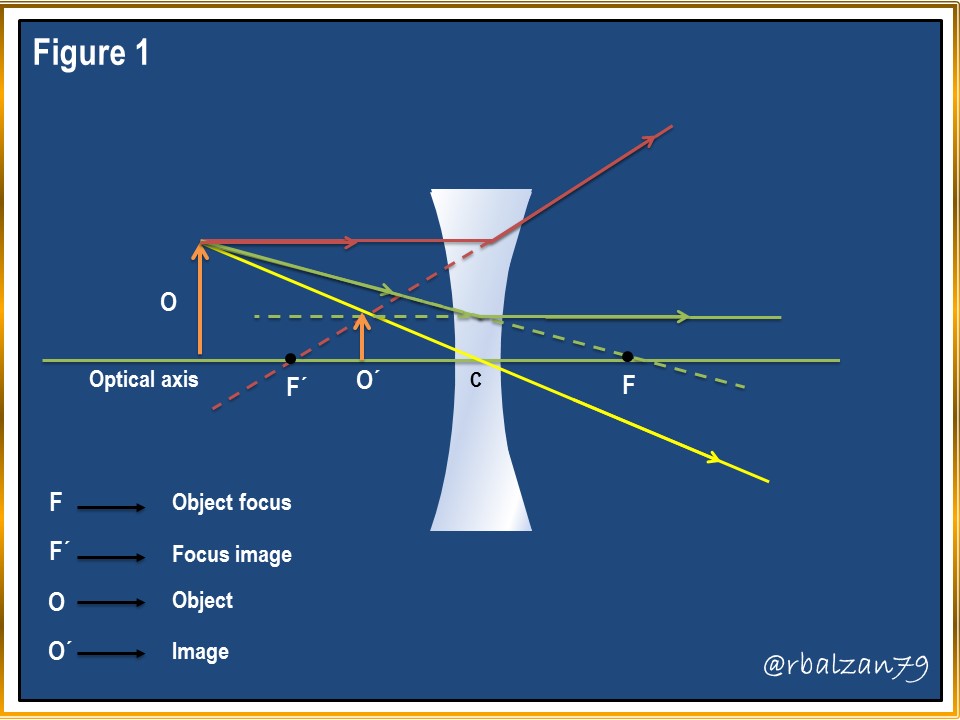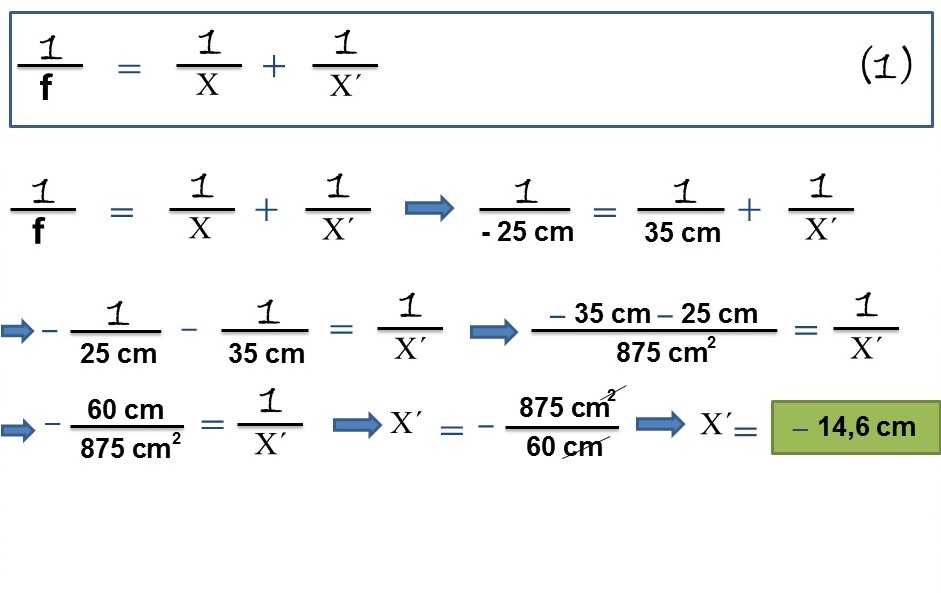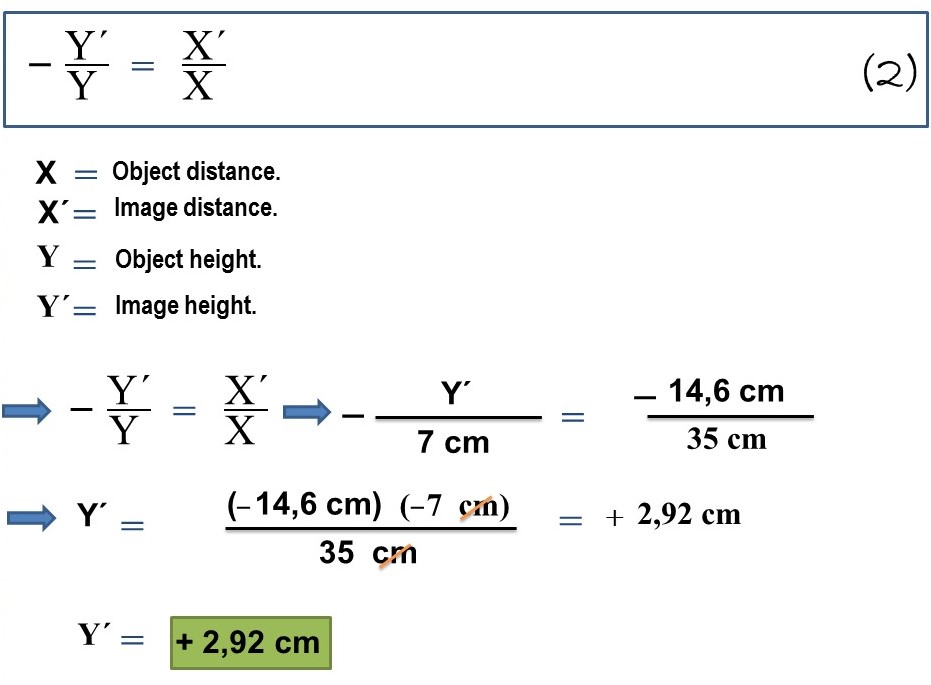Calculations of variables in image generation in a diverging lens

In the same way as we did for convergent or positive lenses, it is necessary to indicate certain characteristics of divergent or negative lenses, for example; This type of lenses are thicker at their ends than in the center, they also have two foci (object focus and image focus), but, unlike convergent lenses, both foci are located differently in divergent lenses, for example; the object focus is located on the transmission side of the light rays and its image focus is located on the incidence side of the light rays.
For the analysis of a divergent lens we also have its optical axis, highlighting that these lenses generate virtual images, straight (not inverted) and smaller, another aspect to highlight is the focal length, where, in this type of divergent lenses this value is taken as negative, for the realization of the scheme of light rays we can use three rays, however, as in convergent lenses, with two rays we could locate the generation of the image of the lens.
Therefore, in order to better understand what has been described above, we can visualize the following figure 1, and thus note the scheme of the light rays on one side and the other side of a diverging lens.

In the previous figure 1, we could notice the action of three light rays departing from the object to be analyzed, the red ray departing parallel to the optical axis and when refracted it deviates from the object focus (F), the green ray whose projection passes through the focus (object) when it hits the lens and refracts it propagates parallel to the optical axis and the yellow ray, which passes through the center of the divergent lens does not deviate, in relation to the above mentioned, let us structure our exercise.
Exercise
In order to verify the behavior of light rays in a diverging lens, we place an object of 7 cm height at a distance of 35 cm from the lens, whose focal length is -25 cm, therefore, we answer the following question:
a.- Applying a ray diagram analysis verify, what will be the position of the image generated by the diverging lens and, the size of the image?
Solución
Data:
Y = 7 cm (Object height).
X = 35 cm (Object distance).
f = -25 cm (Focal length).
X´= ? (Distance of the image with respect to the converging lens).
Y´= ? (Image height).
To begin the resolution of our proposed exercise, let's start with the realization of the light ray diagram in relation to the characteristics or data proposed above, therefore, we have:

With the structuring of the light ray scheme we can perform our analysis, this time we use only two rays, the one that leaves parallel to the optical axis and deviates from the object focus when refracted by the divergent lens, but, which is projected by the image focus and intersects with the yellow ray that passes through the center of the lens without refracting, that intersection gives us the location of the image.
a.- Now for the calculation of the position of this image we use the equation of the thin lens, but now with the characteristic of the rays incident on a divergent lens as observed in figure 2.

Applying the formula 1, and substituting the known values we can arrive at the requested value, that is, the distance of the image in relation to the diverging lens giving a distance of -14.6 cm, the negative sign indicates that the image is generated on the incidence side of the light rays, therefore, it is virtual, now we have to calculate the size of the image and its orientation, we do this with the following formulation.

In this way we can calculate the height of our image formed by the luminous rays when incident and refracted in the divergent lens giving a value of 2.92 cm, the positive sign indicates that the image is right, that is, not inverted.
Conclusion
Our main objective was to demonstrate the difference in the behavior of the luminous rays when impacting divergent lenses, this, in relation to convergent lenses, the ray schemes are different, the focuses both object and image are inverted between one lens and another, a feature that stands out in the analysis of these lenses, In convergent lenses the light rays converge once refracted by the optical system, while in divergent lenses the same does not happen, that is why the image is sought from the extensions of the light rays incident and refracted in these divergent lenses.
We use the same formulations, but both graphically and analytically the behavior is different in these lenses, in this analysis we verify how in this type of divergent lenses the images generated will always be virtual (not real), straight (not inverted) and decreased in size in relation to the object analyzed, with the understanding of the phenomenon of light and its formulations in relation to the lenses we continue to demonstrate its essential applications in our daily life.
Until another opportunity my dear friends.
Note: The images were created by the author using Power Point and Paint, the animated gif using PhotoScape.
Recommended bibliographic references
[1] GEOMETRIC OPTICS. Link.
[2] Lens Basics. Link.
Thanks for your contribution to the STEMsocial community. Feel free to join us on discord to get to know the rest of us!
Please consider delegating to the @stemsocial account (85% of the curation rewards are returned).
You may also include @stemsocial as a beneficiary of the rewards of this post to get a stronger support.
Thank you for the valuable support dear @stemsocial community.